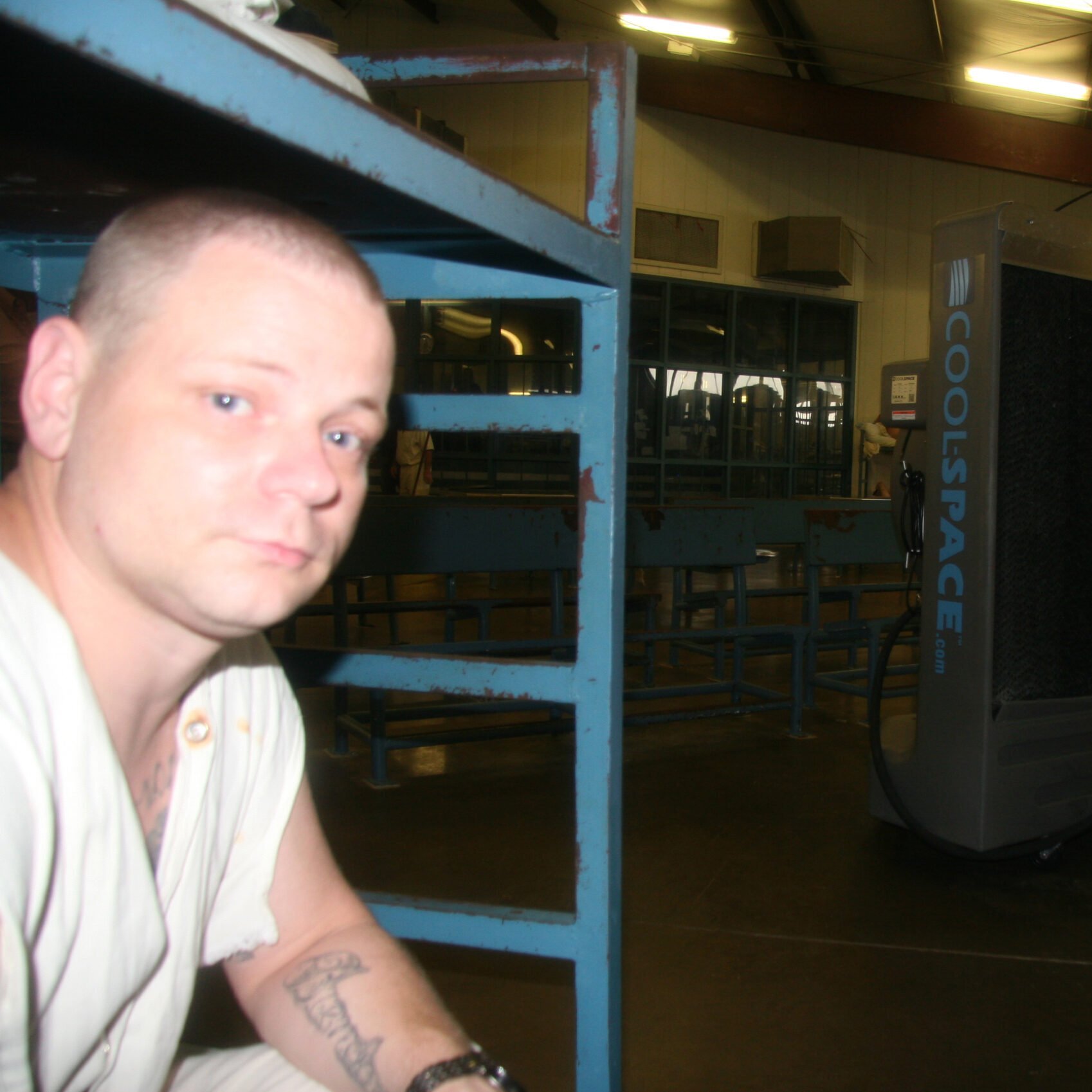
‘It Will Take the Breath Out of You’: Prisoners Describe Extreme Nighttime Heat in Texas Units
TDCJ will allocate $85 million to provide more air conditioning. In the meantime, people are sweltering in their beds.

The H. H. Coffield Unit prison near Tennessee Colony is made up of squat redbrick buildings. During the day, the sun beats down on the walls, and the bricks drink in the heat. At night, the heat seeps out of the walls into the cells. That’s when Joshua Sweeting, who’s been at the Coffield Unit since 2019, says the heat is the most unbearable.
“It will take the breath out of you,” he told the Texas Observer in written correspondence.
Built in 1965, the unit houses more than 3,800 men. None of their cells currently have air-conditioning. Sweeting is in solitary, so he has extra steel welded onto his door. He says if it’s 110 degrees Fahrenheit in the wing, it’s at least five to ten degrees hotter in the cells. Staffing shortages mean fewer guards are available to run cool-down showers and distribute cold water, both lifelines for people trying to cope with the state’s record-breaking heat.
“I’m not innocent, I broke the law and deserve to pay for my crime,” Sweeting wrote. “However, I’m still a human. They even have warnings on the radio to bring in plants and animals due to the heat, but we sit here and fry.”
“I’m not innocent, I broke the law and deserve to pay for my crime. However, I’m still a human.”
David Rodgers, also at the Coffield Unit, developed a heat rash covering his whole body, from his face to his feet. The rash looked like hives, and it was painful: He said it “feels like pins sticking you when you start to sweat.” When he sought help from medical staff, he was given a cream and told to try to stay as cool as he could. This would be tough—Rodgers said he lives in the hottest area of the unit, and prison officials denied multiple requests for him to be moved to a cool bed.
He also said nighttime in the unit provides no relief.
“At night it get[s] bad. I lay there and it feels like I want to throw up, and I’m so thirsty that when I get up to drink water out [of] the sink it makes it worse,” he wrote to the Observer. “The fans they sell us … they feel like you are laying under a hair dryer, so really not helping.”
Experts compare using fans in oppressive heat to a convection oven. Rodgers said it’s hard to get more than a couple of hours of sleep.
Nighttime heat is an insidious threat, and not just in prisons. Recent research has shown that when the temperature fails to drop when the sun goes down, people’s bodies aren’t able to recover from the damage caused during the day. This, paired with an inability to sleep in the sweltering heat, contributes to increased risk of heat-related deaths. And this is becoming a big issue for people without access to air-conditioning, as global nighttime temperatures appear to be increasing at a faster rate than daytime temperatures.
Coffield is one of 14 prisons with no air-conditioning in its housing areas, and 55 units only have partial AC in housing areas, according to data from the Texas Department of Criminal Justice (TDCJ). This means only about a third of all Texas prisons are fully equipped with air-conditioning. The majority of non-air-conditioned units are in the southern and eastern parts of the state, areas that have suffered significantly from record-breaking heat.
TDCJ Director of Communications Amanda Hernandez said respite is “available at all times,” but did not specify what nighttime relief looks like.
Fabian Carrasco, incarcerated at the J. Dale Wainwright Unit in Houston County, wrote to the Observer saying “the bars, bunk and cell walls get hot, not to the point that it can burn you but to the point that you can feel the heat.”
He’s learned to wet the cell walls and floor and turn on commissary-bought fans. This helps reduce the amount of heat that seeps into the cells at night, but it’s not an ideal solution. He has to repeat the wetting and cooling process five to six times a night.
One study found that suicide watches in prison go up an average of 30 percent during extreme heat. The health threats for prisoners and TDCJ employees loom large.
Heat is the deadliest environmental threat, more deadly than floods, tornadoes, and hurricanes combined. But the Texas prison system hasn’t reported a heat-related death since 2012.
One researcher found that 271 deaths in the system between 2001 and 2019 could have been heat related. At the same time, there has been a recent spike in prison deaths in the state—an additional two people dying per 10,000 this summer, Texas Public Radio found—and family members and advocates are not buying the idea that the heat wasn’t the killer. Advocates held a vigil at the governor’s mansion in August to call attention to people who have died in custody.
According to TDCJ data, temperatures reached as high as 106 degrees Fahrenheit inside some prisons in June.
In Texas prisons, there is no legal requirement to keep the heat down, as there is in state jails, where the maximum temperature is 85 degrees Fahrenheit. Dispatches from inside Texas prisons show an exceedingly harsh reality for people in TDCJ custody. According to the agency’s own data, temperatures reached as high as 106 degrees Fahrenheit inside some prisons in June.
The fight over climate control in Texas prisons is not new. TDCJ has faced multiple lawsuits—including in 2012 and in 2018—filed by prisoners and advocates concerned over excessive heat. Still, it might have more political capital now: Last month, Democrats on the U.S. House Committee on Oversight and Accountability requested an investigation into nationwide heat mitigation in prisons.
At the Texas Board of Criminal Justice’s August 25 meeting, Tona Naranjo spoke on behalf of her son John Anthony Southards, who died in TDCJ custody on June 28.
“Ladies and gentlemen of the board, I myself turned my son in [out of] tough love,” she told the board. “I believed in doing so that my son would be rehabilitated. He would pay his debt to society. And he would come home a different young man. Two of those things did not happen. He was not rehabilitated. He did come home a different young man: a dead one.”



